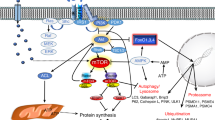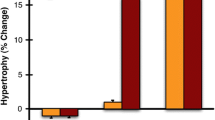Abstract
Muscle has an intrinsic ability to adapt to different types of work by changing fibre type and muscle mass. This process involves quantitative and qualitative changes in gene expression including those of the myosin heavy chain (MyHC) isogenes that encode different types of molecular motors. Increased expression of slow MyHC and of metabolic genes result in increased fatigue resistance. Recently, there has been some insight into how oxidative metabolism, as well as slow myosin expression, is regulated and the role of calcium in initiating switches in gene expression. In relation to muscle mass and power output it has been appreciated that local as well as systemic factors are important. Our group have cloned three types of IGF-I in human muscle which are derived from the IGF-I gene by alternative splicing. The expression of one of these that appears to be an autocrine/paracrine splice variant is only detectable after mechanical stimulation (MGF) and a systemic type (IGF-IEa) that is produced by the liver and other tissue including muscle. As the result of a reading frame shift, the MGF peptide has a different C terminal sequence to IGF-IEa. Interestingly, the MGF C terminal peptide has been found to act as a separate growth factor and to initially activate mononluceated myoblasts (satellite cells). MGF also responds to different signals and has different expression kinetics to IGF-IEa. The mechanotransduction mechanism for this signalling may directly or indirectly involve the dystrophin complex as dystrophic muscle, unlike normal muscle, is unable to express MGF in response to overload. Also the ability to express MGF has been found to decline markedly during ageing. The deficiency in expressing MGF and activating satellite cells in dystrophic and aged muscles may explain why muscle mass is not maintained in these situations. However, in normal muscle MGF appears to initiate local muscle repair with its over expression resulting in hypertrophy.
Similar content being viewed by others
References
Andersen JL and Aagaard P (2002) Myosin heavy chain IIX overshoot in human skeletal muscle. Muscle Nerve 23: 1095–1104.
Andersen JL, Weiss A, Sandri C, Schjerling P, Thonell LE, Pedrosa-Domellof F, Leinwand L and Schiaffino S (2002) The 2B myosin heavy chain gene is expressed in human skeletal muscle. J Physiol 539P: 29P.
Barton-Davis ER, LaFramboise WA and Kushmerick MJ (1996) Activity-dependent induction of slow myosin gene expression in isolated fast-twitch mouse muscle. Am J Physiol 271: C1409–C1414.
Barton-Davis ER, Shoturma DI, Musaro A, Rosenthal N and Sweeny HL (1998) Viral mediated expression of insulin-like growth factor I blocks the aging-related loss of skeletal muscle function. Proc Natl Acad Sci USA 95: 15603–15607.
Brahm H, Piehl-Aulin K, Saltin B and Ljunghall S (1997) Net fluxes over working thigh of hormones, growth factors and biomarkers of bone metabolism during lasting dynamic exercise. Calcified Tissue 60: 175–180.
Brenman JE, Chao DS, Xia H, Aldape K and Bredt DS (1995) Nitric oxide synthase complexed with dystrophin and absent from skeletal muscle sarcolemma in Duchenne muscular dystrophy. Cell 82: 743–752.
Ennion S, Sant'ana Pereira J, Sargeant AJ, Young A and Goldspink G (1995) Characterization of human skeletal muscle fibres according to the myosin heavy chain they express. J Muscle Res Cell Motil 16: 35–43.
Freund HJ (1983) Motor unit and muscle activity in voluntary motor control. Physiol Rev 63: 387–436.
Gauvry L, Ennion S, Hansen E, Butterworth P and Goldspink G (1996) The characterisation of the 5′ regulatory region of a temperature-induced myosin-heavy-chain gene associated with muscle growth in the carp. Eur J Biochem 236: 887–894.
Gerlach GF, Turay L, Malik K, Lida J, Scutt A and Goldspink G (1990) The mechanisms of seasonal temperature acclimation in the carp; a combined physiological and molecular biology approach. Am J Physiol 259: R237–R244.
Goldspink DF and Goldspink G (1986) In: Nix WA and Vrbova G (eds) Electrical Stimulation and Neuromuscular Disorders. (pp. 91–100) Springer Verlag, London.
Goldspink G, Scutt A, Loughna P, Wells DJ, Jaenicke T and Gerlach G-F (1992) Gene expression in skeletal muscle in response to stretch and force generation. Am J Physiol 262: R326–R363.
Goldspink G, Yang SY, Skarli M and Vrbova G (1996) Local growth regulation is associated with an isoform of IGF-I that is expressed in normal muscle but not in dystrophic muscle mdx or dydy mouse muscles when subjected to stretch. J Physiol 495P: 162P–163P.
Griffin G, Williams PE and Goldspink G (1971) Region of longitudinal growth in striated muscle fibres. Nature New Biol 232: 28–29.
Hameed M, Orrell RW, Cobbold M, Goldspink G and Harridge SDR (2003a) Expression of IGF-I splice variants in young and old skeletal muscle after high resistance exercise. J Physiol 541: 247–254.
Hameed M, Lange KHW, Andersen JL, Schjerling P, Kjaer M, Harridge SDR and Goldspink G (2003b) The effect of recombinant human growth hormone and resistance being an IGF-I mRNA expression in the muscles of the elderly. J Physiol (in press).
Harridge SDR, Andersen JL, Hartkopp A, Zhou S, Biering-Sørensen, Sandri C and Kjær M (2002) Training by low-frequency stimulation of tibialis anterior in spinal cord-injured men. Muscle Nerve 25: 685–694.
Henneman E (1985) The size principle: a deterministic output emerges from a set of probabilistic connections. J Exp Biol 115: 105–112.
Hill AV (1950) The dimensions of animals and their muscular dynamics. Sci Prog 38: 209–230.
Hill M and Goldspink G (in press) Expression and splicing of the insulin-like growth factor gene in rodent muscle is associated with muscle satellite (stem) cell activation following local tissue damage. J Physiol 549: 409–418.
Hill M, Wernig A and Goldspink G (2003b) Muscle satellite (stem) cell activation during local tissue injury and repair. J Anat 203: 89–99.
Hnik P, Vejsada J, Goldspink DF, Kasiciki S and Krekule I (1985) Quantitative evaluation of electromyogram activity in rat extensor and flexor muscles immobilized at different lengths. Exp Neurol 88: 515–528.
Lin CS, Chan JH, Pierrot-Deseilligny E and Burke D (2002) Excitability of human muscle afferents using threshold tracking of the H reflex. J Physiol 545: 661–669.
Mathews LS, Hammer RE, Behringer RR, D'Ercole AJ, Bell CL, Brinster RL and Palmiter RD (1988) Growth enhancement of transgenic mice expressing human insulin-like growth factor I. Endocrinology 123: 2827–2833.
McKoy G, Ashley W, Mander J, Yang S, Williams N, Russell B and Goldspink G (1999) Expression of insulin growth factor-1 splice variants and structural genes in rabbit skeletal muscle induced by stretch and stimulation. J Physiol 516: 583–592.
Meißner JD, Gros G, Scheibe RJ, Scholz M and Kubbis HP (2001) Calcineurin regulates slow myosin but not fast myosin or metabolic enzymes, during fast-to-slow transformation in rabbit skeletal muscle cell culture. J Physiol 533: 215–226.
Meißner JD, Kubis H-P, Scheibe RJ and Gros G (2000) Reversible Ca2+-induced fast-to-slow transition in primary skeletal muscle culture cells at the mRNA level. J Physiol 523: 19–28.
Owino V, Yang SY and Goldspink G (2001) Age-related loss of skeletal muscle function and the inability to express the autocrine form of insulin-like growth factor-I (MGF) in response to mechanical overload. FEBS Lett 505: 259–263.
Pette D and Staron RS (1990) Cellular and molecular diversities of mammalian skeletal muscle fibers. Rev Physiol Biochem Pharmacol 116: 1–76.
Pette D and Vrbova G (1986) Neural control of phenotypic expression in mammalian muscle fibres. Muscle Nerve 8: 876–689.
Sant'Ana Pereira J, Ennion S, Sargeant AJ, Moorman AFM and Goldspink G (1997) Eur J Physiol 435: 151–163.
Smerdu V, Karsch-Mizrachi I, Campione M, Leinwand L and Schiaffino S (1994) Type IIx myosin heavy chain transcripts are expressed in type IIb fibers of human skeletal muscle. Am J Physiol 36: 1723–1728.
Sreter FA, Pinter K, Jolesz F and Mabuch I (1982) Fast to slow transformation of fast muscles in response to long-term phasic stimulation. Exp Neurol 75: 95–102.
Tabary JC, Tabary C, Tardieu C, Tardieu G and Goldspink G (1972) Physiological and structural changes in the cat’s soleus muscle due to immobilization at different lengths by plaster casts. J Physiol 224: 231–244.
Watabe S, Guo XF and Hwang GC (1994) Carp express specific isoforms of the myosin cross-bridge head, subfragment-1, in association with cold and warm temperature acclimation. J Therm Biol 19: 261–268.
Williams PE and Goldspink G (1973) Longitudinal growth of striated muscle fibres. J Cell Sci 9: 751–767.
Williams P, Watt P, Bicik V and Goldspink G (1986) Effect of stretch combined with electrical stimulation on the type of sarcomeres produced at the ends of muscle fibers. Exp Neurol 93: 500–509.
Wolff JA, Malone RW, Williams P, Chong W, Ascadi G, Jani A and Felgner PL (1990) Direct gene transfer into mouse muscle in vivo. Science 247: 1465–1468.
Yang S, Alnqeeb M, Simpson H and Goldspink G (1996) Cloning and characterisation of an IGF-I isoform expressed in skeletal muscle subjected to stretch. J Muscle Res Cell Motil 17: 487–495.
Yang SY and Goldspink G (2002) Different roles of the IGF-IEc peptide (MGF) and mature IGF-I in myoblast proliferation and differentiation. FEBS Lett 522: 156–160.
Yang SY, Alnaqeeb M, Simpson H and Goldspink G (1997) Changes in muscle fibre type, muscle mass and IGF-I gene expression in rabbit skeletal muscle subjected to stretch. J Anat 190: 613–622.
Author information
Authors and Affiliations
Rights and permissions
About this article
Cite this article
Goldspink, G. Gene expression in muscle in response to exercise. J Muscle Res Cell Motil 24, 121–126 (2003). https://doi.org/10.1023/A:1026041228041
Issue Date:
DOI: https://doi.org/10.1023/A:1026041228041




